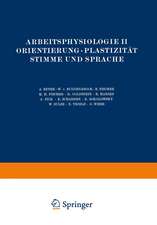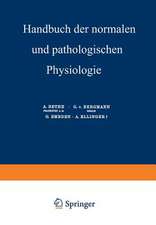Running Mechanics and Gait Analysis
Autor Reed Ferber, Shari MacDonalden Limba Engleză Paperback – 15 apr 2014
Preț: 392.15 lei
Preț vechi: 412.80 lei
-5% Nou
75.04€ • 78.34$ • 62.10£
Carte disponibilă
Livrare economică 15-29 martie
Livrare express 01-07 martie pentru 28.26 lei
Specificații
ISBN-10: 1450424392
Pagini: 152
Ilustrații: 14 black & white halftones, 60 colour illustrations
Dimensiuni: 179 x 255 x 10 mm
Greutate: 0.32 kg
Editura: MG – Human Kinetics
Descriere
A premier resource that is dedicated to running
Running Mechanics and Gait Analysis With Online Video is the premier resource dedicated to running mechanics and injury prevention. Running continues to be one of the most popular sports, despite the fact that up to 70 percent of runners will sustain overuse injuries during any one-year period. Therefore, it is imperative for health care professionals, coaches, and runners themselves to be informed on injury prevention and optimal treatment. Referencing over 250 peer-reviewed scientific manuscripts, this text is a comprehensive review of the most recent research and clinical concepts related to gait and injury analysis.
Running Mechanics and Gait Analysis With Online Video supplies professionals with an expansive array of clinical applications. Physical therapists and athletic trainers will come away with an understanding of ways to build on standard practice, while runners, coaches, and personal trainers will gain a new appreciation for the performance benefits that gait analysis can provide. The text has the following features:
- A discussion of the complexities of running biomechanics as they relate to muscular strength, flexibility, and anatomical alignment for the purpose of providing an advanced clinical assessment of gait
- Guidelines for assessing, treating, and preventing a range of common and not-so-common running injuries
- A detailed analysis of running biomechanics to help professionals identify the interactions of the kinetic chain and the causes of overuse injuries
- A video library featuring 33 clips that demonstrate the biomechanical patterns discussed in the text
- Documented clinical examples to help practitioners apply the wealth of information in the book to their own practice
Early chapters introduce readers to the basics of running-related injuries, foot mechanics, and shoe selection before progressing to discussions of knee and hip mechanics, ways to influence gait mechanics, and technical aspects of video gait analysis. Via a detailed joint-by-joint analysis, the book pinpoints common problem areas for runners and describes protocols for treatment. Later chapters present case studies of injured runners to guide professionals through a detailed biomechanical analysis and treatment recommendations, and an overview chapter summarizes the interrelationships of movement patterns at each joint with anatomical, strength, flexibility, and kinetic chain factors.
Running Mechanics and Gait Analysis With Online Video is the most comprehensive resource for running-related research. Readers will come away armed with the knowledge and tools to perform an advanced clinical assessment of gait and rehabilitate and prevent running injuries.
Continuing education credits/units may also be earned on this topic. The Running Mechanics and Gait Analysis Online CE Course includes the complete e-book, online video, and a continuing education exam.
mechanics and injury prevention. Referencing over 250 peer-reviewed scientific manuscripts, it is a comprehensive review of the most recent research and clinical concepts related to gait and injury analysis.
Cuprins
Chapter 1. Incidence of Running-Related Injuries
Defining an Overuse Injury
Etiology of Overuse Injuries in Runners
Common Running-Related Injuries
Understanding Clinical and Biomechanical Risk Factors
Summary
Chapter 2. Assessing Foot Mechanics
Biomechanics
Atypical Foot Mechanics and Injury
Strength
Anatomical Alignment
Flexibility
Summary
Chapter 3. Footwear Selection
Overview of Running Shoes
Footwear Research Findings
Shoe Fitting
Barefoot Running
Orthotic Devices and Foot Mechanics
Summary
Chapter 4. Assessing Knee Mechanics
Biomechanics
Strength
Anatomical Alignment
Flexibility
Summary
Chapter 5. Assessing Hip Mechanics
Biomechanics
Strength
Anatomical Alignment
Flexibility
Summary
Chapter 6. Proximal to Distal Relationships: Case Studies
Torsional Forces
Frontal Plane Mechanics
Summary
Chapter 7. Can We Influence Gait Mechanics?
Feedback
Strength Training
Revisiting the Case Studies
Summary
Chapter 8. Overview of Clinical and Biomechanical Assessment
Foot, Ankle, and Tibia
Knee
Hip
Summary
Chapter 9. Technical Aspects of Video Gait Analysis
Sampling Frequency
F-Stop and Shutter Speed
Software Options
Summary
Afterword
Appendix: Terminology for Gait Biomechanics
Glossary
References
Index
















